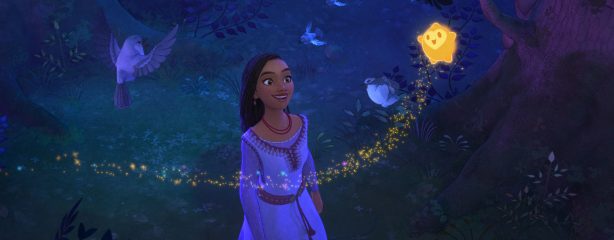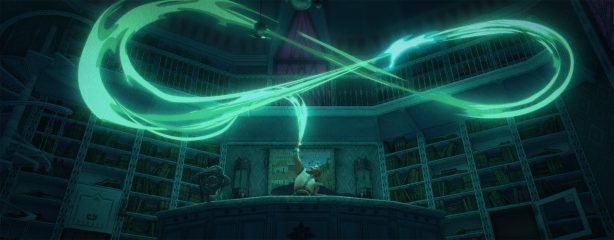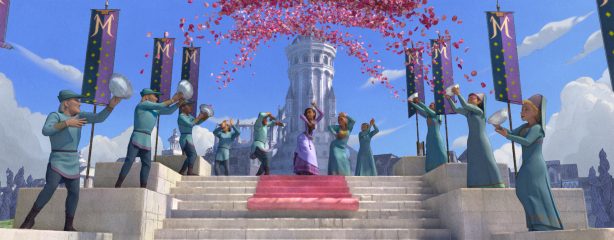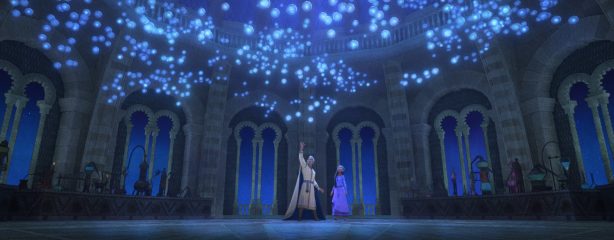The visuals of Disney’s Wish—which opens in theaters on Wednesday—is unlike any Disney animated feature film that has come before it. Yet, at the same time, the film pays tribute to the beauty and style that has defined Disney Animation for the last 100 years.
Wish tells the story of the idealistic Asha, who with the help of a magical star, takes on an evil king. It touches on Disney’s history of fairy tale storytelling mixed with dynamic music and unforgettable characters. The film also blends the past, present and potential future of Disney Animation in terms of its visual production design.
This is thanks—in large part—to Michael Giaimo and Kyle Odermatt.

Giaimo—who is the production designer of Wish (and before that, held the role on both Frozen features)—and Odermatt—the VFX supervisor of the film (who previously worked on Moana, Raya and the Last Dragon and Big Hero 6)—offered a fresh look for the movie by bringing together stunning 3-D animation with the watercolor storybook style that is a hallmark of Disney animated classics.
“I remember [Director Chris Buck] saying that his favorite Disney film was Pinocchio when he was a kid growing up,” Giaimo said. “And since he mentioned that and since this was going to be a fairy tale, I thought, ‘well, what can we do to honor the Walt Disney legacy as well as what we are doing as contemporary animation filmmakers?”
Giaimo added that the film’s style “involved a couple of visual elements,” including the watercolor technique for backgrounds and line work around the environment and the characters. According to Odermatt, the production had “a small group that talked about the cinematography of the film and talked a lot about the style and how we would use it.”

For Odermatt, it was about the audience feeling the paper texture in the watercolor style, noticing where the line work was and wasn’t, and focusing on “where the illustrator wants your eye to be.” He noted that Disney had worked with this style before with Paperman—2012’s Academy Award-winning animated short—but never with a full-length feature film.
“That’s actually one of the exciting things about these big tasks that we take on… the unknown,” he said. “In the end, we came up with an incredible system… that allows for that very consistent, integrated feel of that watercolor paper texture over every frame.”
The sharpness, feel and colors of the film also means that it’s best seen on the biggest screen possible.

“We did get feedback right away when the trailer released. People would view it on their phone, and then some had the opportunity to see it on a larger screen and were shocked,” Giaimo said. “You’re looking at a small format. You really can’t perceive all the watercolor and paper texture. You really have to experience it on a larger one.”
Wish is inspired by many of Disney Animation’s 61 feature films over its history, but three films in particular stand out: 1937’s Snow White and the Seven Dwarfs, 1940’s Pinocchio and 1959’s Sleeping Beauty.
“For the watercolor look, which primarily drives the film, [Snow White and Pinocchio] were the two main shows, and Sleeping Beauty was leveraged in a couple of ways, probably in the largest way, which is both Sleeping Beauty and Wish have a very wide screen ratio,” Giaimo said. He added that with Wish the team of animators wanted an “intimate storybook feeling on a grand scale.” That’s why they chose the warm embrace of the watercolor style across a wide screen.

But above all else, what Wish celebrates most during the company’s 100th anniversary is Disney Animation’s commitment to innovation and finding new ways to tell timeless stories.
“I think it shows that we should constantly be exploring,” Odermatt said. “We hope that directors of projects in the future would love to explore a vision that’s in their brain for what the imagery can be.”